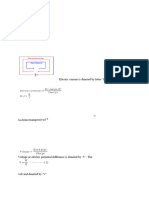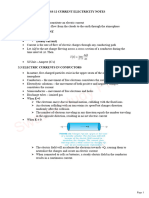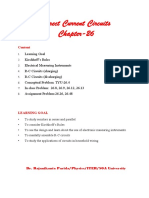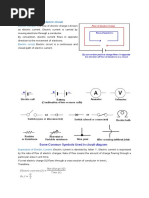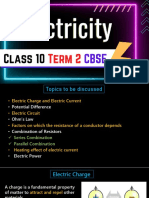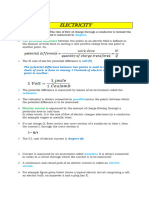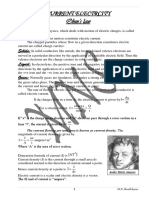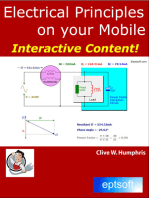0 ratings0% found this document useful (0 votes)
14 viewsCurrent Electricity
Current Electricity
Uploaded by
sukaina fatima1) Current electricity is the study of charges in motion, while electrostatics is the study of charges at rest.
2) In a conductor, free electrons are in random thermal motion but create no net current. Applying an external voltage causes the electrons to flow predominantly in one direction, creating a current.
3) Current is defined as the rate of flow of electric charge through a surface area. It is measured in Amperes, with 1 Ampere equaling 1 Coulomb of charge passing through an area in 1 second.
Copyright:
© All Rights Reserved
Available Formats
Download as PDF, TXT or read online from Scribd
Current Electricity
Current Electricity
Uploaded by
sukaina fatima0 ratings0% found this document useful (0 votes)
14 views16 pages1) Current electricity is the study of charges in motion, while electrostatics is the study of charges at rest.
2) In a conductor, free electrons are in random thermal motion but create no net current. Applying an external voltage causes the electrons to flow predominantly in one direction, creating a current.
3) Current is defined as the rate of flow of electric charge through a surface area. It is measured in Amperes, with 1 Ampere equaling 1 Coulomb of charge passing through an area in 1 second.
Original Description:
class 12
Original Title
CURRENT ELECTRICITY (1)
Copyright
© © All Rights Reserved
Available Formats
PDF, TXT or read online from Scribd
Share this document
Did you find this document useful?
Is this content inappropriate?
1) Current electricity is the study of charges in motion, while electrostatics is the study of charges at rest.
2) In a conductor, free electrons are in random thermal motion but create no net current. Applying an external voltage causes the electrons to flow predominantly in one direction, creating a current.
3) Current is defined as the rate of flow of electric charge through a surface area. It is measured in Amperes, with 1 Ampere equaling 1 Coulomb of charge passing through an area in 1 second.
Copyright:
© All Rights Reserved
Available Formats
Download as PDF, TXT or read online from Scribd
Download as pdf or txt
0 ratings0% found this document useful (0 votes)
14 views16 pagesCurrent Electricity
Current Electricity
Uploaded by
sukaina fatima1) Current electricity is the study of charges in motion, while electrostatics is the study of charges at rest.
2) In a conductor, free electrons are in random thermal motion but create no net current. Applying an external voltage causes the electrons to flow predominantly in one direction, creating a current.
3) Current is defined as the rate of flow of electric charge through a surface area. It is measured in Amperes, with 1 Ampere equaling 1 Coulomb of charge passing through an area in 1 second.
Copyright:
© All Rights Reserved
Available Formats
Download as PDF, TXT or read online from Scribd
Download as pdf or txt
You are on page 1of 16
CURRENT ELECTRICITY
Electrostatics is the study of charges at rest while current electricity is
the study of charges in motion.
Source of Electric Current
• Conductor : According to the kinetic theory the free electrons are in
continuous motion. Consider first the case when no electric field is present.
The electrons will be moving due to thermal motion during which they collide
with the fixed ions. An electron colliding with an ion emerges with the same
speed as before the collision. However, the direction of its velocity after the
collision is completely random. This is called thermal velocity of an
electron.At a given time, there is no preferential direction for the velocities of
the electrons. Thus on the average, the number of electrons travelling in any
direction will be equal to the number of electrons travelling in the opposite
direction. Net motion of charge in a particular direction is zero So, there will
be no net electric current. When this conductor is connected with source of
E.M.F the free electron will move only in one direction. This unidirectional
movement of electrons create current in a conductor.
• Electrolyte solution: there are positively charged and negatively charged
ions, which are in motion. When an external source is connected negatively
charged ions move towards positive electrode and positively charged ions
move towards negative electrode
• Semiconductor : flow of both electrons and holes create current.
• Electric current :
• Electric current is defined as the rate of flow of the electric charge
• through any the area of cross-section of the conductor i.e
• Electric current = Total charge flowing / time taken
• if q is the amount of steady flow of charge through the conductor in t
sec, The current through the conductor is given by I=q/t
• If the charge flow is varying, then instantaneous current at any instant
(t )is
• SI unit of the current is Ampere (A)
• 1 Ampere = 1 Coulomb/ 1 sec =1 Cs-1
• Thus current through any conductor is said to be 1 ampere, if 1 C of charge
is flowing through the conductor in 1 sec
• Small amount of currents are
mill amperes (1mA=10-3 A) or
micro ampere (1 μA=10-6 A)
• Direction of electric current is in the direction of the flow of positive
charged carriers and this current is known as conventional current.
• Direction of the flow of electron in conductor gives the direction of
electronic current. Direction of conventional current is opposite to that of
electronic current
• Electric current is a scalar quantity
Current density (j) :
• The current density at a point in the conductor is defined
as the current per unit cross-section area. j =I / A
• Direction of current density is same as the direction of
conventional current
• Note that current density is a vector quantity unlike
electric current
• Unit of current density is Ampere/meter2 (Am^-2)
Ohm's Law and Resistance :
• Statement of Ohm's Law : Current (I) flowing through a conductor is
always directly proportional to the potential difference (V) across
the two ends of the conductor provided temperature and physical
conditions remain the same
• Mathematically , V α I , V=IR ------------------(1)
Where constant of proportionality R is called the electric resistance or
simply resistance of the conductor
• R = V/I;
Thus electric resistance is the ratio of potential difference across the
two ends of conductor and amount of current flowing through the
conductor
• Electric resistance of a conductor is the opposition offered by the
conductor to the flow of the current through it.
SI unit of resistance is ohm (Ω) where
1 Ohm=1 volt/1 Ampere or 1Ω=1VA^-1 .
• The resistance of conductor is said to be 1 ohm, if
1ampere of current flows through it, when a
potential difference of one volt is applied across it.
Dimension of resistance is [ML^2T^-3A^-2)
Factors affecting the resistance of a conductor
• Length of the conductor : As length of the conductor increases
resistances increases , R α L
• Area of cross section : As area of cross section increases resistances
decreases, R α 1/A
R α L/A ; R = ρ L / A ; ρ = resistivity or specific resistance
Combination of Resistors in Series:
Resistors are said to be connected in series combination. If same current flows
through each resistor when same potential difference is applied across the
combination.
Three resistors R1, R2 and R3 are connected in series combination.
If battery is connected across the series combination so as to maintain potential
difference V between points A and B, the current I would pass through each
resistor.
If V1, V2 and V3 is the potential difference across each resistorR1, R2 and R3
respectively, then according to Ohm's Law
V1=IR1 , V2=IR2 , V3=IR3
Since in series combination current remains same but potential is divided so,
V = V1+ V2+ V3
Total potential across the combination V = IR
V = I (R1 + R2 + R3 )
IR = I (R1 + R2 + R3 )
Rs = R1 + R2 + R3
Rs is the resistance equivalent to the series combination of R1, R2 and R3.
Thus when the resistors are connected in series, equivalent resistance of the
series combination is equal to the sum of individual resistances.
Value of resistance of the series combination is always greater than the value
of largest individual resistances.
For n numbers of resistors connected in series equivalent resistance would
be Rs = R1 + R2 + R3 +...........................+ Rn
If n number of resistors of same value of resistance are connected in series
then Rs = nR
Combination of Resistors in parallel:
Resistors are said to be connected in parallel combination if potential
difference across each resistors is same but current is divided.
Battery B is connected across parallel combination of resistors so as to
maintain potential difference V across each resistors. Then total current in
the circuit would be
I = I1 + I2 + I3
Since potential difference across each resistors is V. Therefore, on applying
Ohm's Law
V = I1R1 = I2R2 =I3R3
You might also like
- Electricity Note DC Current PDFDocument8 pagesElectricity Note DC Current PDFSolomonNo ratings yet
- B GR 11 Chapter 10 NotesDocument13 pagesB GR 11 Chapter 10 NotesKo Win Myint SoeNo ratings yet
- Direct Current D.C.Document10 pagesDirect Current D.C.Puran BistaNo ratings yet
- ChapterDocument8 pagesChapterkokoNo ratings yet
- Current and Resistance Current and Current DensityDocument20 pagesCurrent and Resistance Current and Current Densityminhajul.cse.diuNo ratings yet
- Electricity 10thDocument45 pagesElectricity 10thSuryank sharmaNo ratings yet
- Made By:-Uttam Kumar. X - ADocument36 pagesMade By:-Uttam Kumar. X - ASa HaNo ratings yet
- Electric CircuitDocument118 pagesElectric CircuitDeepa ShreeNo ratings yet
- D.C. CircuitDocument64 pagesD.C. CircuitKim MNo ratings yet
- Electricity Class 10 Notes Science Chapter 12Document11 pagesElectricity Class 10 Notes Science Chapter 12vatnik100% (1)
- MLP ElectricityDocument8 pagesMLP Electricityvartika.guptaNo ratings yet
- Ch3 Formula SheetDocument26 pagesCh3 Formula SheetNancy SinghNo ratings yet
- Electricity Study MaterialDocument7 pagesElectricity Study Materialshreekarpatil47272No ratings yet
- Electricity Study MaterialDocument7 pagesElectricity Study Materialk theshadNo ratings yet
- Study Combination of Resistors in Series.Document11 pagesStudy Combination of Resistors in Series.Tooba Rizwan100% (1)
- ElectricityDocument7 pagesElectricitypranjaltyagi61No ratings yet
- Electricity NtsDocument8 pagesElectricity Ntsdevikaverma2021No ratings yet
- Chapter - 12: ElectricityDocument22 pagesChapter - 12: ElectricityAgrasen SinghNo ratings yet
- Current Electricity 2024 - 25Document9 pagesCurrent Electricity 2024 - 25Mithul VPNo ratings yet
- UnitNo1DCCircuitspptx 2022 10 08 15 08 30pptx 2022 11 03 21 34 27Document66 pagesUnitNo1DCCircuitspptx 2022 10 08 15 08 30pptx 2022 11 03 21 34 27DUSHIMIMANA ROBIN mefgiNo ratings yet
- 26 - Direct-Current Circuits - R K Parida.Document11 pages26 - Direct-Current Circuits - R K Parida.MonicaNo ratings yet
- DC CircuitDocument46 pagesDC Circuitamansapkota14No ratings yet
- CBSE Class 10 Science Notes Chapter 11 ElectricityDocument16 pagesCBSE Class 10 Science Notes Chapter 11 ElectricityHarshith ReddyNo ratings yet
- Direct Current - Docx 2Document8 pagesDirect Current - Docx 2Ali Bin SadatNo ratings yet
- 3.2 Electric CurrentDocument36 pages3.2 Electric CurrenttaufiqstuneNo ratings yet
- Made by:-Pushkar.U X - CDocument36 pagesMade by:-Pushkar.U X - Cpushkar umarjiNo ratings yet
- Unit 2 Module 1Document48 pagesUnit 2 Module 17sky7harveyNo ratings yet
- Electricity 140622103843 Phpapp02Document36 pagesElectricity 140622103843 Phpapp02Venkat Nikhil KotagiriNo ratings yet
- Electricity NotesDocument9 pagesElectricity Notesdhakshineashkg2007No ratings yet
- 1201221548000480Document5 pages1201221548000480krupa.k2408No ratings yet
- 09 CurrentElectricity IDocument9 pages09 CurrentElectricity ILearner PointNo ratings yet
- CBSE Class 10 Science Notes Chapter 12 ElectricityDocument8 pagesCBSE Class 10 Science Notes Chapter 12 Electricitydocumentsfile2024No ratings yet
- ELECTRICITYDocument4 pagesELECTRICITYopgamer7084No ratings yet
- Class 10th Electricity (Notes)Document10 pagesClass 10th Electricity (Notes)Kamya SyalNo ratings yet
- Elecrticity PDFDocument8 pagesElecrticity PDFmrneetgamerNo ratings yet
- Electricity NotesDocument10 pagesElectricity NotesTictacNo ratings yet
- Current ElectricityDocument112 pagesCurrent Electricitymkg_met2391No ratings yet
- Current Electricity Latest 2023 - 17aa175d 3382 4a65 9ad5 Bad8694c983aDocument9 pagesCurrent Electricity Latest 2023 - 17aa175d 3382 4a65 9ad5 Bad8694c983asnigdha varshaNo ratings yet
- EletricityDocument14 pagesEletricitynoahin26No ratings yet
- Class 10,Chapter-ElectricityDocument53 pagesClass 10,Chapter-ElectricityNeog RupakNo ratings yet
- CLASS 10 ELECTRICITYDocument43 pagesCLASS 10 ELECTRICITYbrahmitrustNo ratings yet
- E 6Document9 pagesE 6fgrxperiaz2No ratings yet
- Class 10th Electricity NotesDocument8 pagesClass 10th Electricity Notesfaizanghori783No ratings yet
- Current ElecricityDocument131 pagesCurrent ElecricityD SiddaiahNo ratings yet
- Physics 20 PDFDocument30 pagesPhysics 20 PDFShivani Shree SundaramoorthyNo ratings yet
- Electricity: Electric CurrentDocument4 pagesElectricity: Electric CurrentSuman DasNo ratings yet
- ElectricityDocument35 pagesElectricityPoorna MathivananNo ratings yet
- CURRENT ELECTRICITY (1)Document16 pagesCURRENT ELECTRICITY (1)Aditya SinghNo ratings yet
- Physics Project: Class Xii SESSION 2021-2022Document16 pagesPhysics Project: Class Xii SESSION 2021-2022Coc6 GuptaNo ratings yet
- 10.Electricity Notes (5)Document10 pages10.Electricity Notes (5)rihansajeer13No ratings yet
- Study Material and Notes of CH 12 Electricity Class 10th. Topics in The ChapterDocument5 pagesStudy Material and Notes of CH 12 Electricity Class 10th. Topics in The ChapterSavita ChauhanNo ratings yet
- 2024-2025-Class X-Physics-Chapter 3-AWDocument19 pages2024-2025-Class X-Physics-Chapter 3-AWInaaya KhanNo ratings yet
- Class 10 Science Chapter 12 Electricity Revision NotesDocument25 pagesClass 10 Science Chapter 12 Electricity Revision NotesschoolpublicmailNo ratings yet
- Ohm's LawDocument13 pagesOhm's LawVenu GopalNo ratings yet
- CBSE-Class-12-Physics-Chapter-3-Current-Electricity-Revision-NotesDocument60 pagesCBSE-Class-12-Physics-Chapter-3-Current-Electricity-Revision-Noteskoo62135No ratings yet
- electricity (1)Document8 pageselectricity (1)anikarnayak307No ratings yet
- Chap 7. Notes Alternating CurrentDocument20 pagesChap 7. Notes Alternating Currentsukaina fatimaNo ratings yet
- Chapter 9 Co Ordination CompoundsDocument46 pagesChapter 9 Co Ordination Compoundssukaina fatimaNo ratings yet
- 12-Poitical Science-Revision ScheduleDocument3 pages12-Poitical Science-Revision Schedulesukaina fatimaNo ratings yet
- Work Energy - NotesDocument5 pagesWork Energy - Notessukaina fatimaNo ratings yet
- WS - Job Application - CV - Resume 1Document4 pagesWS - Job Application - CV - Resume 1sukaina fatimaNo ratings yet
- Portion PT1Document3 pagesPortion PT1sukaina fatimaNo ratings yet
- Worksheet - Chapter 7 - EvolutionDocument3 pagesWorksheet - Chapter 7 - Evolutionsukaina fatimaNo ratings yet
- Physics Record Book NotesDocument21 pagesPhysics Record Book Notessukaina fatimaNo ratings yet
- UNIT 12 Aldehydes, Ketones & Carboxylic AcidsDocument50 pagesUNIT 12 Aldehydes, Ketones & Carboxylic Acidssukaina fatima100% (1)
- BiologyDocument4 pagesBiologysukaina fatimaNo ratings yet
- Chap 13 Nitrogen CompoundsDocument43 pagesChap 13 Nitrogen Compoundssukaina fatimaNo ratings yet
- InformaticsDocument8 pagesInformaticssukaina fatimaNo ratings yet
- Chapter 2 Solutions OtturDocument34 pagesChapter 2 Solutions Ottursukaina fatimaNo ratings yet
- CHAPTER 7 Alcohols RESTOREDDocument51 pagesCHAPTER 7 Alcohols RESTOREDsukaina fatimaNo ratings yet
- Unit 3 ElectrochemistryDocument51 pagesUnit 3 Electrochemistrysukaina fatimaNo ratings yet
- Type Series VCM: Negative Pressure Switches (Vacuum Switch)Document3 pagesType Series VCM: Negative Pressure Switches (Vacuum Switch)harisNo ratings yet
- TPEL2009 - Capacitor Ripple Current in An Interleaved PFC ConverterDocument10 pagesTPEL2009 - Capacitor Ripple Current in An Interleaved PFC ConverterXuân Phúc LươngNo ratings yet
- Source ChangeoverDocument116 pagesSource ChangeoverDiana ConsstantinNo ratings yet
- 3 - Diversity Protection SwitchingDocument20 pages3 - Diversity Protection SwitchingMarkNo ratings yet
- P95Dw Block Diagram: Rear Block Main Block Front BlockDocument6 pagesP95Dw Block Diagram: Rear Block Main Block Front BlockYohanemesNo ratings yet
- Garmin 400 Maintenance Manual PDFDocument168 pagesGarmin 400 Maintenance Manual PDFluis andrade100% (2)
- FAT Procedure of LV SwitchboardsDocument17 pagesFAT Procedure of LV SwitchboardsWilliam Wong100% (2)
- REDA Pump DataDocument13 pagesREDA Pump DataStan Andrei100% (4)
- ChannelVision 1215118698 - A BUS - AB 114 - AB 202 - AB 301 - AB 404 InsDocument6 pagesChannelVision 1215118698 - A BUS - AB 114 - AB 202 - AB 301 - AB 404 InsKirboidNo ratings yet
- 4 Kirchhoff's LawsDocument34 pages4 Kirchhoff's LawsNainum FAREEDNo ratings yet
- Upqc PDFDocument14 pagesUpqc PDFsayedjavedalamNo ratings yet
- Human/Machine Interfaces: CatalogDocument16 pagesHuman/Machine Interfaces: Catalogمحمد امين التشغيل الآليNo ratings yet
- ZKD Amc BoqDocument6 pagesZKD Amc BoqA A Mamun KhanNo ratings yet
- Current Transformers, Voltage Transformers, Distribution TransformersDocument7 pagesCurrent Transformers, Voltage Transformers, Distribution TransformersSharafat Ali100% (1)
- Feeder Protection and Control REF601 and REJ601 ANSI: Product GuideDocument20 pagesFeeder Protection and Control REF601 and REJ601 ANSI: Product GuideAdarsh SharmaNo ratings yet
- Battery ModelingDocument6 pagesBattery ModelingmusabnajeebNo ratings yet
- Visible Light CommunicationDocument17 pagesVisible Light CommunicationARDHRA BNo ratings yet
- GENFOCUS COMPANY PORTFOLIO - CompressedDocument40 pagesGENFOCUS COMPANY PORTFOLIO - CompressedBDMNo ratings yet
- EE306 Power System AnalysisDocument2 pagesEE306 Power System AnalysisPriyadarshini SahooNo ratings yet
- Element Sighn Range of Applications Tehnical Data Similare Equipment RemarkDocument2 pagesElement Sighn Range of Applications Tehnical Data Similare Equipment RemarkVladimir ĐorđevićNo ratings yet
- Kollmorgen AKD CANopen Communications Manual En-Us Rev HDocument162 pagesKollmorgen AKD CANopen Communications Manual En-Us Rev HMaycon Santos da SilveiraNo ratings yet
- DSP Revision 2022-2023Document17 pagesDSP Revision 2022-2023abdalallh shabaanNo ratings yet
- Company Profile-Jaya ElectricalsDocument3 pagesCompany Profile-Jaya ElectricalsSharafat Ali100% (1)
- ABB Surge Arrester POLIM-D PI - Data Sheet 1HC0093997 E01 AADocument6 pagesABB Surge Arrester POLIM-D PI - Data Sheet 1HC0093997 E01 AAHan HuangNo ratings yet
- 0017-5311 V01 - Vestas Standard For Electrical SafetyDocument44 pages0017-5311 V01 - Vestas Standard For Electrical SafetyNestor Gomez SalasNo ratings yet
- Full Optus Guide MetvDocument32 pagesFull Optus Guide Metvjohnpoulianakis0% (1)
- PhysicsDocument9 pagesPhysicsGanesh VNo ratings yet
- 5216 1 PDFDocument24 pages5216 1 PDFDeepak Kumar Rout100% (1)
- Toma Industrial Sobreponer FamatelDocument2 pagesToma Industrial Sobreponer FamatelHENRY MICHELNo ratings yet
- Me6702 MechatronicsDocument7 pagesMe6702 Mechatronicsazidahaka61No ratings yet










